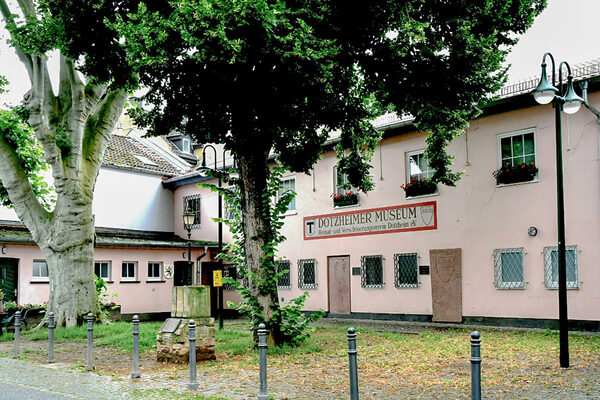From Tuozesheim to Dotzheim
From Celtic settlements to Frankish farmsteads and large modern settlements: Dotzheim looks back on an eventful past.
From the Celts to the Franks
Dotzheim's history dates back to the early Iron Age. Celtic settlements existed there from around 400 BC, as evidenced by stone box graves in Hohlstraße. The Romans also left their mark: in 222 AD, Fortunatus and Sejus donated an altar, fragments of which are still preserved today.
In the sixth century, after the victory of the Merovingian king Clovis over the Alemanni, Frankish settlement began. One of the king's followers settled in the Belzbach valley and gave the village its name: Over the centuries, "Tuozesheim" became " Dotzheim".
The Middle Ages and church property
Dotzheim was first mentioned in writing in 1128. At this time, church institutions dominated life in the village. Monasteries such as St. Alban and Eberbach owned extensive estates, including vineyards. A document from the Eberbach monastery dated June 24, 1275 mentions Dotzheim wine for the first time: Knight Philipp von Frauenstein donated land in Dotzheim to the monastery, which included a mill and twelve acres of vineyards.
In the 13th and 14th centuries, noble families emerged who called themselves "von Dotzheim". Their donations, such as the Gothic side chapels of the Eberbach monastery church, bear witness to Dotzheim's importance at this time.
The largest village in the Nassau region
In 1610, a fire destroyed around half of Dotzheim's buildings. The Thirty Years' War hit the town even harder: in 1644 it was almost completely depopulated. Dotzheim only recovered from the consequences of the war decades later. A new rectory was built in 1695 and a schoolhouse in 1698. The parish church was rebuilt between 1716 and 1718.
In the 18th century, Dotzheim stabilized and in the 19th century it developed into a residential community. Many residents found work in the neighboring cosmopolitan spa town of Wiesbaden. Until the 19th century, Dotzheim was considered the "largest village in the Nassau region". With industrialization and the connection to the Langenschwalbach railroad in 1889, the community experienced an economic boom. A flourishing commercial area developed around the railroad station.
War and incorporation
The First World War, followed by the French occupation, inflation and the economic crisis, led to considerable burdens for Dotzheim. At times, 3,000 French soldiers were stationed here, and from 1926, British troops took over. The political tensions and economic hardship intensified the desire to join Wiesbaden. This wish was fulfilled on April 1, 1928, exactly 800 years after Dotzheim was first mentioned.
Political tensions and Nazi terror
During the Weimar Republic, Dotzheim was considered a "red Dotzem" due to the high proportion of votes for the KPD and SPD in the Reichstag elections of 1924. After the incorporation, the influence of the NSDAP increased. From 1933, this was followed by the persecution of political opponents, the expulsion and murder of the Jewish community and the destruction of Jewish businesses. The rearmament efforts of the Nazi regime led to the construction of extensive barracks. The Second World War brought some serious destruction to Dotzheim, especially during the air raids in February 1945.
Modern settlements and historical heritage
The settlement of Freudenberg and Märchenland began as early as the 1930s. This was followed by the extensive development of Kohlheck. After the Second World War, Dotzheim continued to grow: new residential areas such as Schelmengraben, designed by Professor May, and Sauerland were developed to meet the increasing demand. Professor May was an important urban planner who played a key role in the development of Wiesbaden.
At the same time, the historical heritage was preserved - for example by Freudenberg Castle and the Nassau Tourist Railway, which keep the history of Dotzheim alive.
Historical highlight
Dotzheim "fibula" from the 7th century: The sheet bronze vestment pin from Dotzheim is an important find from the early Franconian period and is now in the British Museum in London.
